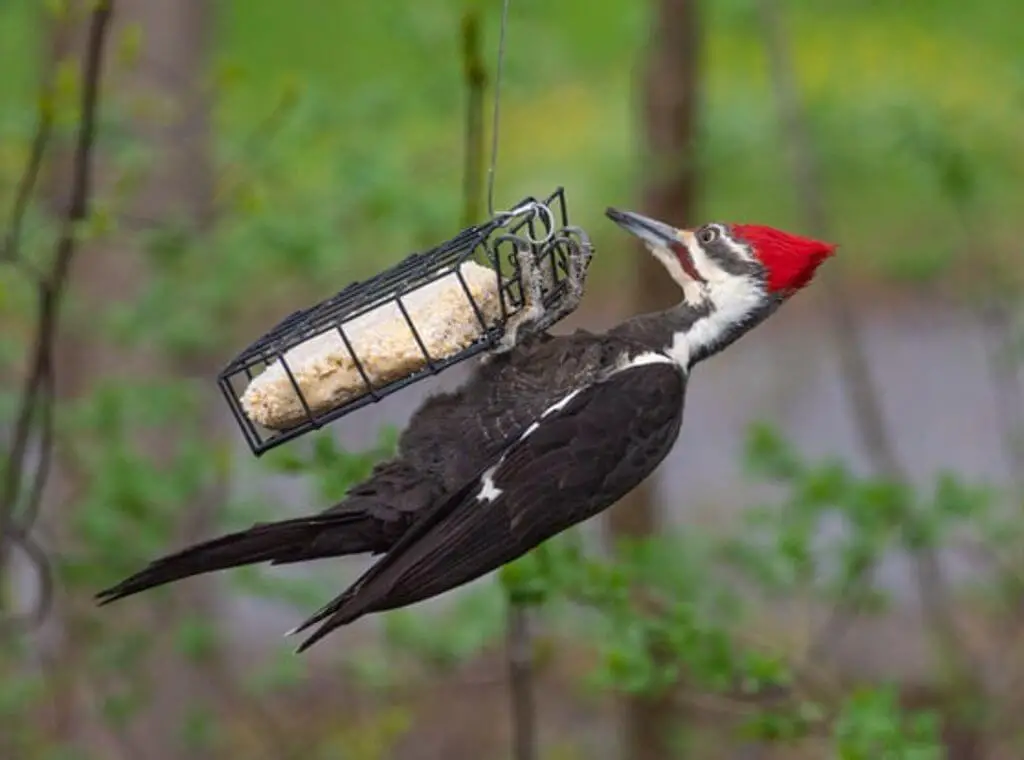Embark on a journey through Michigan’s woodlands with our expert guide to the 11 types of woodpeckers! From the majestic Pileated Woodpecker to the striking Red-bellied Woodpecker, Michigan’s forests provide a diverse habitat for these fascinating birds.
In this comprehensive guide, we’ll dive into the unique characteristics, habitats, and behaviors of each woodpecker species, offering valuable insights for bird enthusiasts and nature lovers alike.
Table of Contents
Types Of Woodpeckers In Michigan
Downy Woodpecker
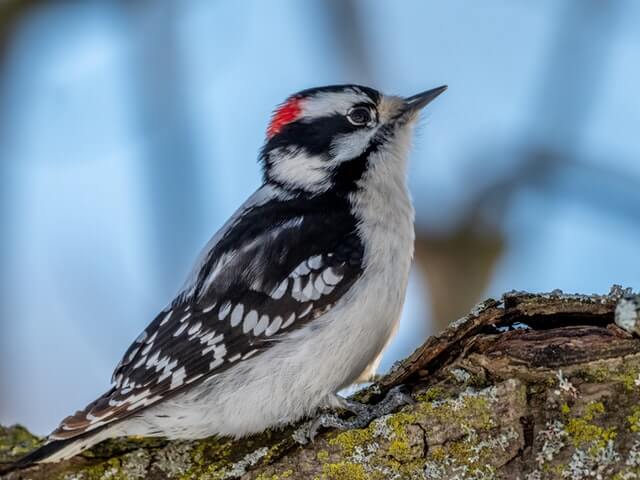
- Length: 5.5-6.7 in (14-17 cm)
- Weight: 0.7-1.0 oz (21-28 g)
- Wingspan: 9.8-11.8 in (25-30 cm)
- Frequency of Occurrence: 34.54% (Statistic by: eBird)
- Where To Find Them: Some places to find Downy Woodpeckers in Michigan include: In the Upper Peninsula, Downy Woodpeckers can be found in the forests around Munising and Marquette. In the Lower Peninsula, Downy Woodpeckers can be found in the Huron-Manistee National Forest, Shiawassee National Wildlife Refuge, and Pontiac Lake Recreation Area.
- How to Attract: One way to draw them in is to provide a food source, such as suet or seeds. You can also install a bird feeder or simply put out a plate of food on the ground. Downy Woodpeckers are also attracted to water, so consider putting out a bird bath or fountain. Finally, make sure you have some trees and shrubs in your yard, as these birds like to hide in dense vegetation. If you can provide all of these things, you’re likely to see Downy Woodpeckers visiting your backyard frequently!
The Downy Woodpecker is a small woodpecker native to the North American continent. Downy Woodpeckers are typically found in open woodlands, parks, and gardens. They primarily eat insects, but also consume fruit and seeds.
Downy Woodpeckers have black and white plumage, a characteristic red cap, and a long black tail. They use their strong beaks to peck into tree bark in search of insects. They are also known to build nests in trees or birdhouses.
Related Post:
- How to Attract Downy Woodpeckers to Your Yard? (Easy!)
- 7 Birds That Look Like Downy Woodpecker (Explained)
Red-bellied Woodpecker
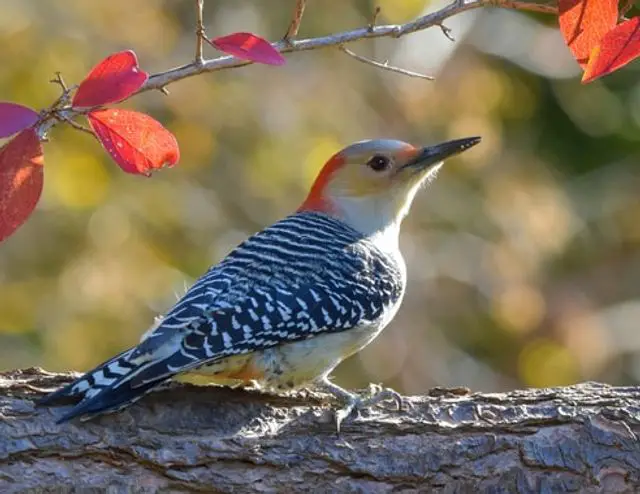
- Length: 9.5 in (24 cm)
- Weight: 2.0-3.2 oz (56-90 g)
- Wingspan: 13.0-16.5 in (33-42 cm)
- Frequency of Occurrence: 29.64%
- Where To Find Them: In Michigan, they are found statewide, but are more common in the Lower Peninsula.
- How to Attract: One thing you can do is provide them with a food source. They like to eat insects, so providing a bird feeder with insect-rich food will attract them. You can also put out suet or nuts, which they will also enjoy. Another thing you can do is create a birdhouse for them to live in. They prefer houses that are made from wood and have a 1 ½ inch entrance hole. You can also make or buy a perching platform for them to use.
The Red-bellied Woodpecker (Melanerpes carolinus) is a medium-sized woodpecker. It is the most common woodpecker in the eastern United States and Canada. The Red-bellied Woodpecker ranges from southern Ontario and Quebec, south to Florida and west to Texas.
It prefers deciduous forests, but also occurs in mixedwoods, parks, suburbs, and even cities. The diet of the Red-bellied Woodpecker consists of insects, including beetles, ants, wasps, bees, and termites; as well as fruits such as berries and acorns.
Related Post: How to Attract Red-bellied Woodpeckers to your Yard?
Northern Flicker

- Length: 11.0-12.0 in (28-31 cm)
- Weight: 3.9-5.6 oz (110-160 g)
- Wingspan: 16.5-20.0 in (42-51 cm)
- Frequency of Occurrence: 19.58%
- Where To Find Them: Some places where they can be found include the Upper Peninsula, Mackinac Island, Porcupine Mountains, Holland, Grand Rapids, Lansing, and Detroit.
- How To Attract: These birds are common in yards and parks, and can often be attracted to feeders by providing a suet feeder or platform feeder with a variety of seeds. In the spring and summer, northern flickers also enjoy eating insects, so it’s also helpful to provide a small pool or bird bath where they can take a quick bath and cool off.
A member of the woodpecker family, the Northern Flicker is a medium-sized woodpecker. It ranges across most of North America, from Alaska and Canada to Panama. In the east, its range extends as far south as Florida and Texas. The northern flicker prefers open woodlands, farms, and suburbs.
This woodpecker feeds mainly on insects, but also eats fruit and seeds. It forages on the ground or in trees, often flipping over leaves or branches with its bill to find food. The northern flicker mates for life and builds a nest of twigs in a tree cavity.
Related Post: How to Attract Northern Flickers to your Backyard (Easy)
Hairy Woodpecker
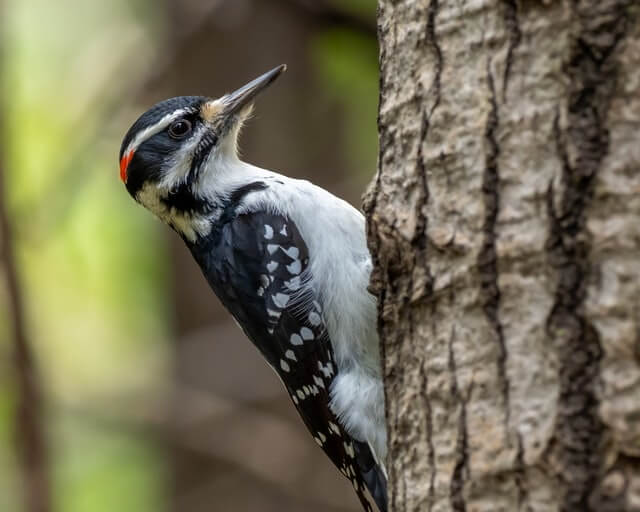
- Length: 7.1-10.2 in (18-26 cm)
- Weight: 1.4-3.4 oz (40-95 g)
- Wingspan: 13.0-16.1 in (33-41 cm)
- Frequency of Occurrence: 14.77%
- Where To Find Them: Some good places to spot them are in the Upper Peninsula, near the Huron Mountain Range, and in the northern lower peninsula near the Mackinac Bridge. They can also be seen in other parts of Michigan, including metropolitan areas like Detroit and Grand Rapids.
- How to Attract: If you want to attract a hairy woodpecker, you can try putting up a suet feeder. This type of feeder is made for birds that eat insects, and it will give the woodpecker a chance to get a quick snack. You can also put out a tray of water near your feeders to help the bird stay hydrated. If you have trees in your yard, you can also try hanging a chunk of bark or an old log for the woodpecker to use as a perch.
The Hairy Woodpecker is a medium-sized woodland bird that ranges throughout most of North America. They prefer deciduous forests, but can also be found in coniferous forests and open areas near trees.
Hairy Woodpeckers eat mainly insects, but also consume fruit and nuts. They nest in tree cavities, excavating their own or using abandoned woodpecker holes. These birds are beneficial to forests because they help control insect populations.
Pileated Woodpecker

- Length: 15.8-19.3 in (40-49 cm)
- Weight: 8.8-12.3 oz (250-350 g)
- Wingspan: 26.0-29.5 in (66-75 cm)
- Frequency of Occurrence: 7.40%
- Where To Find Them: Some places where you might see these birds include the Huron-Manistee National Forest, Shiawassee National Wildlife Refuge, and Pinckney Recreation Area.
- How To Attract: There are several things you can do to attract pileated woodpeckers to your backyard. One is to plant a variety of trees that provide food for them. Dead trees are also a draw, so consider leaving some dead limbs or branches on your trees. You can also put up a bird feeder that offers suet or nuts. Finally, make sure there is a source of water nearby.
The pileated woodpecker is a large woodpecker in North America. It is the second-largest woodpecker in the United States, and the largest in Canada. The bird’s distribution range includes Southern Canada to Central Mexico.
The Pileated woodpecker inhabits both deciduous and coniferous forests, and can be found in both rural and urban areas. These birds forage on the ground for insects, as well as for fruits, nuts, and sap. They also store food in trees for later consumption.
Related Post: How to Attract Pileated Woodpeckers to your Yard (Fast)
Yellow-bellied Sapsucker
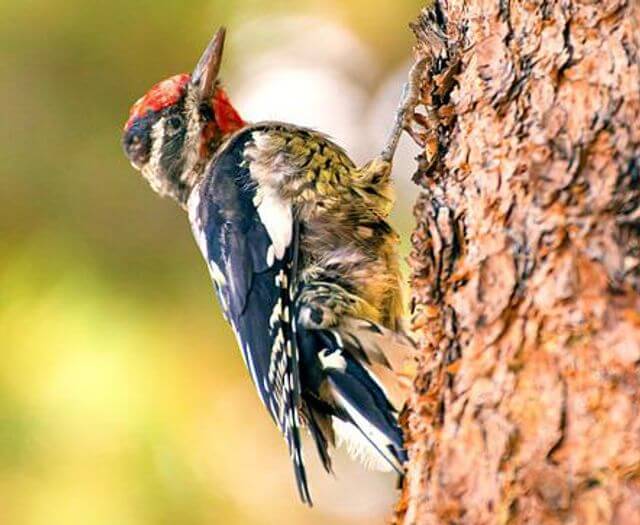
- Length: 7.1-8.7 in (18-22 cm)
- Weight: 1.5-1.9 oz (43-55 g)
- Wingspan: 13.4-15.8 in (34-40 cm)
- Frequency of Occurrence: 2.82%
- Where To Find Them: Some places where they have been seen include the Upper Peninsula, Mackinac County, and Marquette County. They are also known to be in the Lower Peninsula near Howell and Ann Arbor.
- How to Attract: There are several ways to attract a yellow-bellied sapsucker to your backyard. One way is to use suet feeders to provide them with food. Suet is a type of animal fat that sapsuckers love to eat. You can also provide them with a feeder that has holes in it so they can drink sap from trees. If you have any fruit trees in your backyard, make sure to leave some fruit on the ground for the sapsuckers to eat.
The yellow-bellied sapsucker is a North American woodpecker species. It is the only sapsucker found east of the Rocky Mountains. The yellow-bellied sapsucker ranges from central Alaska to Nova Scotia, and south to Texas, Florida, and eastern Mexico.
It inhabits deciduous and mixed forests, as well as parks and urban areas. The diet of the yellow-bellied sapsucker consists mainly of sap from trees, but also includes insects, fruit, nuts, and seeds.
Related Post: 16 Interesting Sapsucker Facts Revealed!
Red-headed Woodpecker
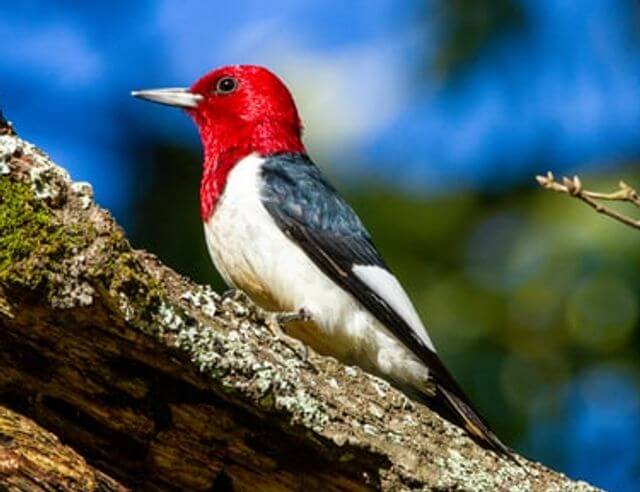
- Length: 7.5-9.1 in (19-23 cm)
- Weight: 2.0-3.2 oz (56-91 g)
- Wingspan: 16.5 in (42 cm)
- Frequency of Occurrence: 1.98%
- Where To Find Them: Their range includes the Lower Peninsula and the Upper Peninsula. They can also be found in some surrounding states, including Wisconsin, Ohio, and Indiana. Some specific places where they have been spotted include Ludington State Park, Hiawatha National Forest, and Hartwick Pines State Park.
- How to Attract: These birds eat a variety of insects, as well as fruit and nuts. They can be attracted to backyards by putting out a feeder with suet or peanut butter, or by planting trees that produce fruit or nuts. The best time to see Red-headed Woodpeckers is in the spring or fall, when they are migrating.
The red-headed woodpecker is a medium-sized woodpecker that ranges throughout most of the eastern and central United States. They typically inhabit deciduous forests, but can also be found in parks, gardens, and orchards. These birds primarily eat insects, but will also consume fruit and nuts.
Red-headed woodpeckers are monogamous and typically mate for life. They build their nests in trees, using pieces of bark, twigs, and leaves. The female lays 3–7 eggs, which both parents incubate for about two weeks. The young leave the nest about two months after hatching.
Related Post:
- Interesting Red-Headed Woodpecker Facts (Explained)
- Birds That Look Like A Red-headed Woodpecker(Explained)
Black-backed Woodpecker

- Length: 9.1 in (23 cm)
- Weight: 2.1-3.1 oz (61-88 g)
- Wingspan: 15.8-16.5 in (40-42 cm)
- Frequency of Occurrence: 0.0567%
- Where To Find Them: Some good places to see black-backed woodpeckers are Isle Royale National Park, Porcupine Mountains State Park, and Tahquamenon Falls State Park.
- How to Attract: Providing a mix of these items in your yard will help attract them. You can also put up a bird feeder or hang a suet cake from a tree. In addition to food, black-backed woodpeckers need a place to live. They prefer areas with large trees that have lots of dead branches for nesting and roosting. You can create this type of habitat by leaving dead trees standing or by creating a dead tree pile.
The Black-backed woodpecker is a medium-sized woodpecker that is found in North America. It is the only woodpecker that is found in both the eastern and western United States. The black-backed woodpecker ranges from southern Canada to central Mexico.
It inhabits a variety of habitats, including forests, woodland edges, and riparian corridors. The black-backed woodpecker feeds on a variety of insects, including beetles, ants, termites, and carpenter ants.
Lewis’s Woodpecker

- Length: 10.2-11.0 in (26-28 cm)
- Weight: 3.1-4.9 oz (88-138 g)
- Wingspan: 19.3-20.5 in (49-52 cm)
- Frequency of Occurrence: 0.0097%
- Where To Find Them: They are most commonly found in Michigan, specifically in the southern and central parts of the state. Some places where they have been spotted include Pinckney State Recreation Area, Waterloo Recreation Area, and Highland Recreation Area.
- How to Attract: This bird is usually found in coniferous forests and can be attracted to backyard feeders by providing suet or seed mixes that include sunflower seeds, peanuts, and raisins. The Lewis’ woodpecker can also be attracted to areas near large trees by putting up a suet feeder on a post or tree near the trunk.
Lewis’s woodpecker, a large North American woodpecker, was named after Meriwether Lewis, one of the pioneers of North America who explored the area which was acquired by the United States via the sale of Louisiana. Lewis’s woodpeckers are found in open coniferous forests and mixed woodlands.
They also occur in riparian habitats, sagebrush flats, and open areas near towns and villages. These birds are not very common, but they can be found in many parts of their range, which extends from southern British Columbia south to Baja California Sur, Mexico. Lewis’s woodpeckers eat insects, spiders, fruit, and seeds.
American Three-toed Woodpecker
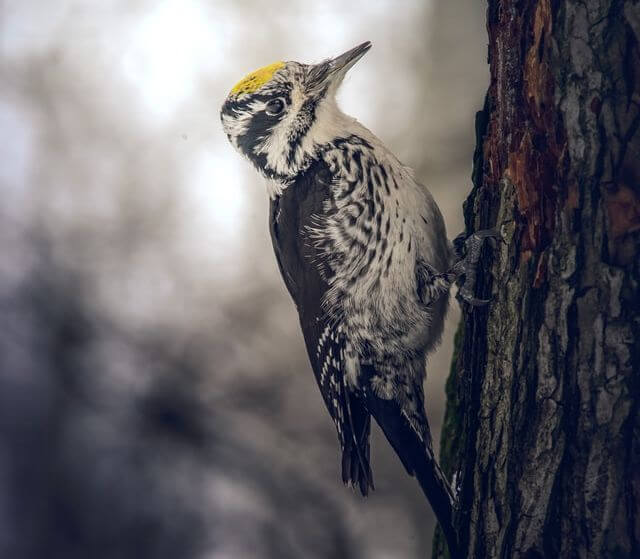
- Length: 8.3-9.1 in (21-23 cm)
- Weight: 1.6-2.4 oz (44.8-67.9 g)
- Wingspan: 14.6-15.3 in (37-39 cm)
- Frequency of Occurrence: 0.0009%
- Where To Find Them: The American three-toed woodpecker is found in many parts of Michigan. Some places where they have been seen include Saginaw Bay, the Upper Peninsula, and the northern Lower Peninsula. They are also common in the forests near Lansing and Jackson.
- How to Attract: If you want to attract these birds to your backyard, you can provide them with a feeder that offers insects or suet, as well as some dead trees or logs for them to search for food on.
The American Three-toed Woodpecker is a medium-sized woodpecker that is found in the forests of western North America. They are specialists in living among old growth forests and use their strong bills to extract insects from decaying logs. Their diet consists mostly of beetles, but they will also eat ants, spiders, and other small invertebrates.
American Three-toed Woodpeckers live in a variety of habitats including coniferous forests, mixed hardwood-coniferous forests, and riparian corridors. They are monogamous birds that typically mate for life.
Red-cockaded Woodpecker
- Length: 7.9-9.1 in (20-23 cm)
- Weight: 1.5-1.8 oz (42-52 g)
- Wingspan: 14.2 in (36 cm)
- Frequency of Occurrence: 0.0001%
- Where To Find Them: there have been sightings of this species in Michigan. In fact, Red-cockaded woodpeckers have been spotted in several places in the state, including near Alpena, Cadillac, and Grayling.
- How to Attract: Red-cockaded woodpeckers can be attracted to your property by creating or preserving an area with mature pine trees. You can also install a wooden nesting box in an appropriate location on your property. If you provide a food source such as suet, these birds will likely visit your yard on a regular basis.
The red-cockaded woodpecker is a federally endangered species found in the southeastern United States. These woodpeckers live in longleaf pine forests and use the trees for nesting, roosting, and foraging. They eat insects, spiders, and other small invertebrates.
The red-cockaded woodpecker’s range has been greatly reduced due to habitat destruction, but they are still found in a number of states including Alabama, Arkansas, Florida, Georgia, Louisiana, Mississippi, North Carolina, South Carolina, and Texas.
Related Post: Most Common Birds of Michigan (with Photos, ID & Info)

